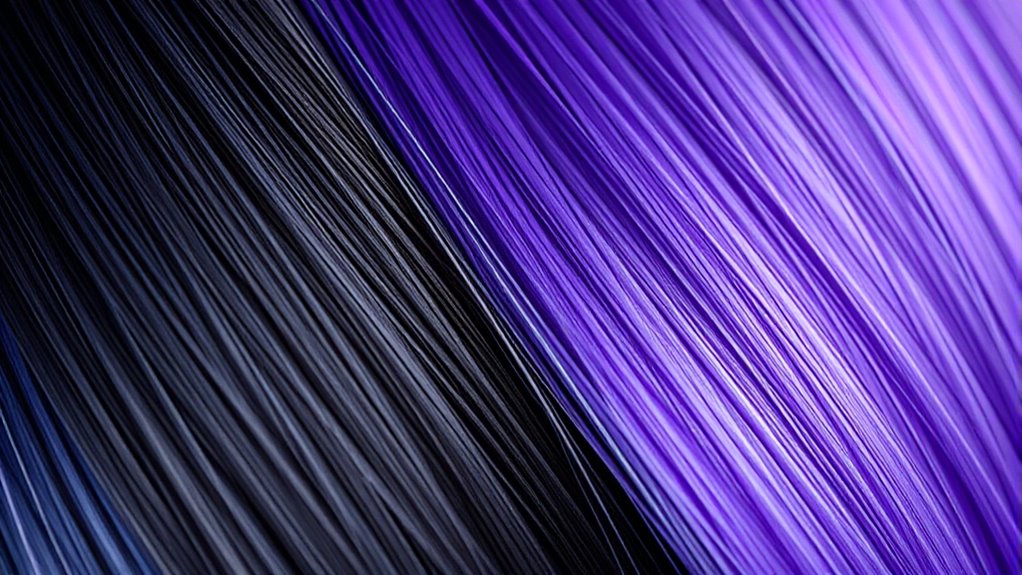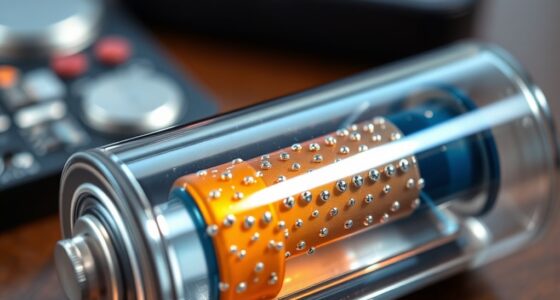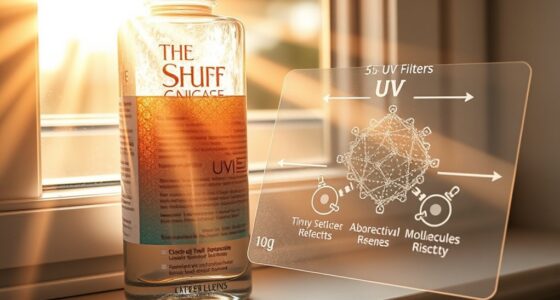Permanent hair dye works by opening your hair’s cuticles with ammonia and hydrogen peroxide, allowing small dye precursors to penetrate the cortex. Inside, these precursors oxidize and form larger, insoluble pigments that are trapped, providing long-lasting color. Semi-permanent dyes coat the surface without penetrating deeply, fading over time. Understanding how these processes differ helps you choose the best option for your desired look and hair condition. Keep exploring to learn how your hair’s structure impacts color results.
Key Takeaways
- Permanent dyes use small precursors that penetrate the cortex and oxidize to form large, stable pigments trapped inside hair.
- Semi-permanent dyes coat the hair surface with medium-sized molecules that do not penetrate deeply and wash out over time.
- Permanent coloring relies on alkaline conditions and hydrogen peroxide to swell cuticles and oxidize natural melanin, creating lasting color.
- Semi-permanent dyes do not contain ammonia or developers; they deposit color without chemical alteration of natural pigments.
- The durability of permanent dyes results from chemical reactions forming insoluble, polymerized pigments inside the hair shaft.
The Layers of Hair and Natural Pigments
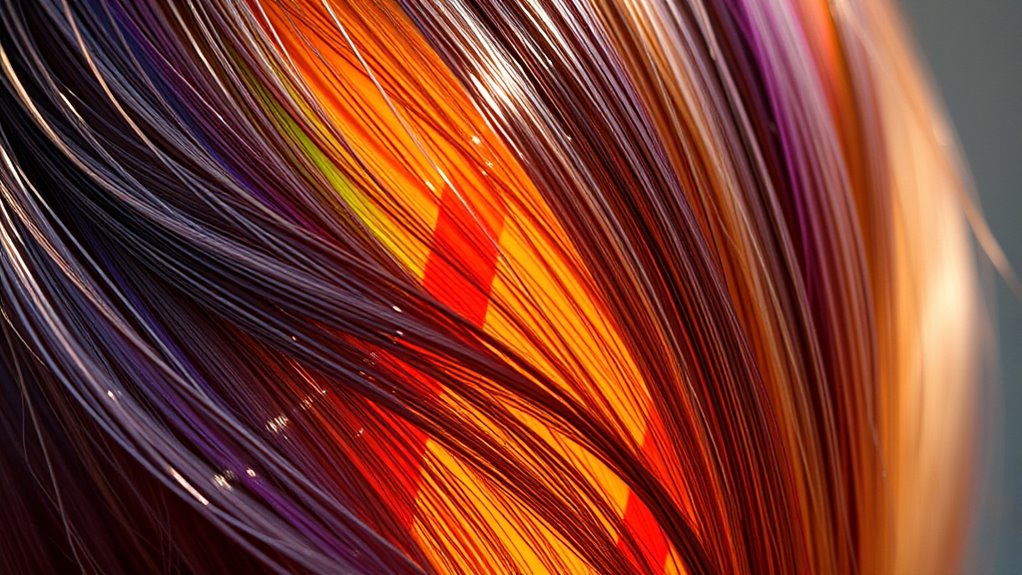
Understanding the structure of your hair helps explain how it looks and reacts to treatments. Your hair has three main layers: the medulla, cortex, and cuticle.
The medulla is the innermost layer, often absent in finer hair, and contains soft cells and oils. Its presence or absence can influence how hair absorbs dyes and chemicals.
The cortex surrounds the medulla and holds most of your hair’s strength, color, and texture. It also influences moisture content and overall health, depending on its condition. Variations in the cortex, especially when compromised, can lead to uneven coloring or damage.
The outermost layer, the cuticle, acts as a protective shield made of overlapping cells resembling shingles. Healthy cuticles are flat and hydrated, preventing damage and moisture loss. The condition of the cuticle is crucial for maintaining hair vibrancy and ensuring effective dye penetration.
Chemical Composition of Permanent Hair Dyes
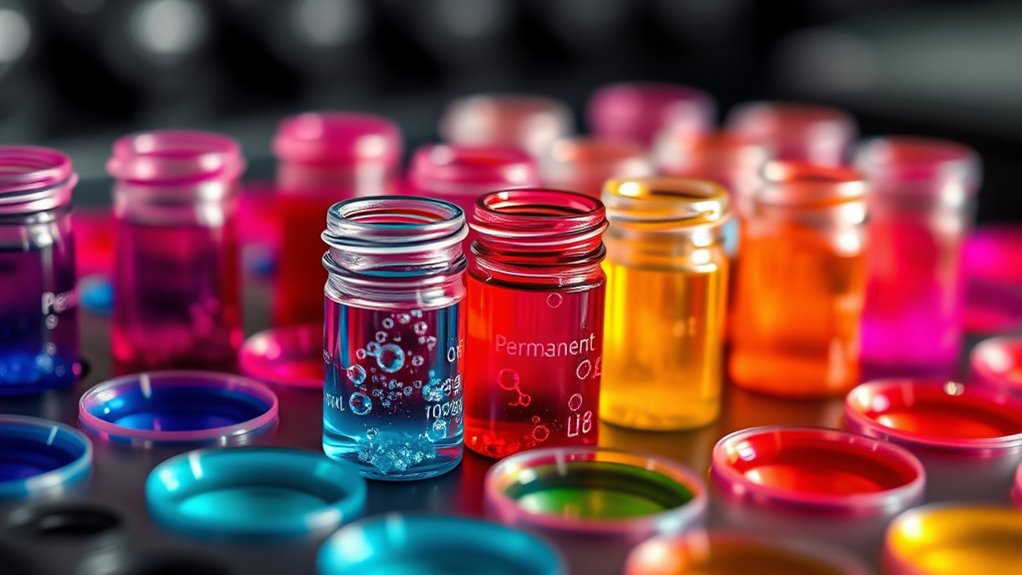
The chemical composition of permanent hair dyes is carefully formulated to penetrate your hair and produce long-lasting color. Ammonia plays a key role by swelling your hair cuticles, making it easier for dye molecules to enter. Hydrogen peroxide acts as an oxidizer, initiating the chemical reactions needed to form permanent color. Additionally, the presence of Dog names can influence the choice of hair dye shades, as some colors are inspired by popular dog breeds. The dye contains primary intermediates, like ortho- and para-aromatic amines, which react with coupling agents such as resorcinol and m-phenylenediamine. These compounds work together in an alkaline environment to develop the desired hue. Alkalizing agents raise the pH, opening the cuticles, while additives like alcohols assist with application but can dry your hair. Once inside the cortex, the dye molecules create a stable, long-lasting color resistant to washing. Chemical reactions involved in dyeing are complex, and understanding hair dye chemistry can help you choose products that are safer and more effective.
How Semi-Permanent Hair Colors Differ
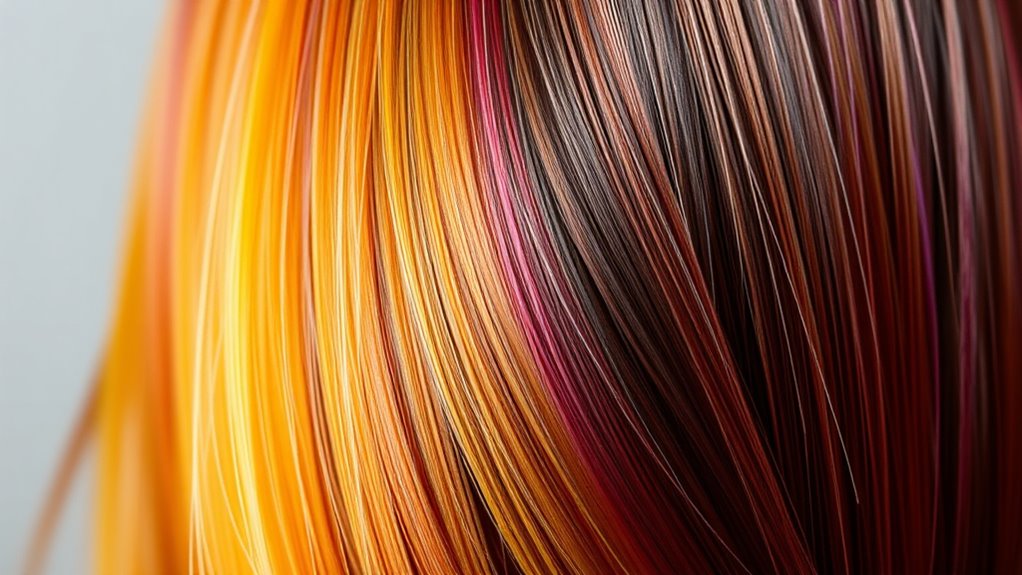
Unlike permanent hair dyes that chemically penetrate and alter your hair’s internal structure, semi-permanent colors coat only the outside of your hair shaft. They’re deposit-only dyes that don’t contain ammonia or require developers, making them gentler and less damaging. These colors sit on the surface and gradually fade over about 3 to 6 washes, as the coating washes away without penetrating the cortex. Because they don’t lift your natural pigment or physically alter your hair, they’re ideal for adding gloss, revitalizing tones, or trying temporary colors. The fade rate is faster than permanent dyes, often lasting around three weeks. You’ll need frequent reapplications to maintain vibrancy, but since they’re less damaging, they’re perfect for short-term style changes and experimenting with bold or vibrant shades. Automation technologies are increasingly used in manufacturing processes to improve efficiency and reduce manual labor, which can also influence how hair dye products are formulated and distributed. Additionally, advancements in formulation technologies help create more consistent and longer-lasting semi-permanent dyes.
The Role of Ammonia and Ph in Hair Coloring
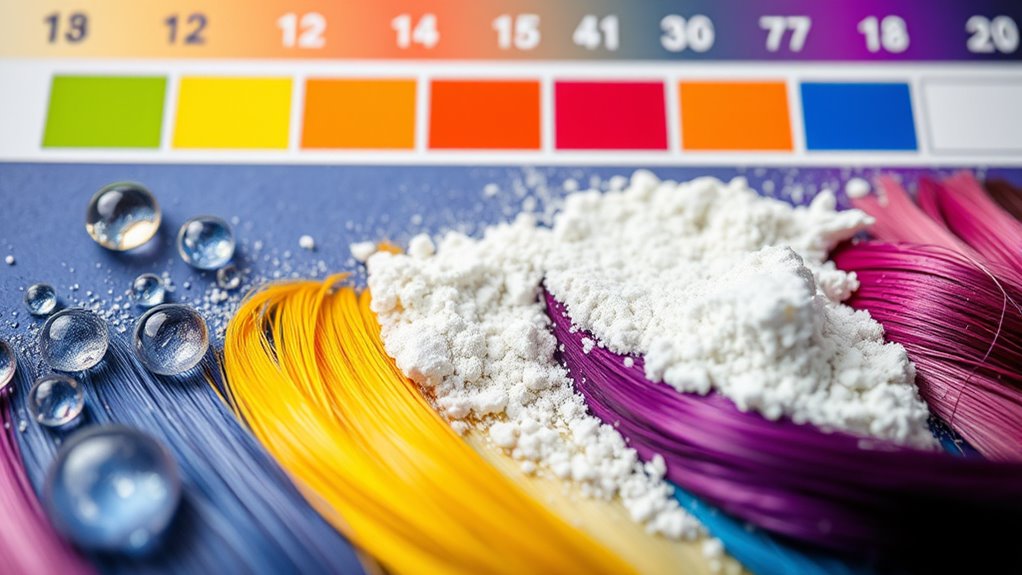
Ammonia plays a crucial role in hair coloring by raising the hair’s pH level, which causes the cuticles to lift and swell. This alkalinity allows dye molecules to penetrate deeply into the cortex, enabling vibrant and long-lasting color. Inspirational quotes about fatherhood serve to motivate and remind us of the importance of guidance and support during transformative processes like hair coloring. Human hair is naturally acidic, with closed cuticles that protect the cortex. Ammonia temporarily shifts this balance, opening the cuticles for better dye absorption. It acts as a swelling agent, ensuring the color can develop inside the hair shaft. The pH increase also facilitates oxidation reactions that create permanent pigments. Since ammonia molecules are small and volatile, they evaporate quickly after application, reducing potential damage. Additionally, understanding the pH balance in hair helps in optimizing the coloring process while minimizing damage, as maintaining proper pH levels is essential for color durability and hair health.
Oxidation Process and Formation of Color Molecules

When dye molecules penetrate the hair cortex, oxidation reactions activate to develop permanent color. Hydrogen peroxide acts as the main oxidizing agent, breaking down natural melanin pigments by disrupting their double bonds, which lightens your hair. This process creates a neutral base for new color.
Dye molecules activate oxidation in the hair cortex, breaking down melanin to create a neutral base for lasting color.
Permanent dyes contain colorless precursors like p-phenylenediamine, which oxidize into reactive quinones. These intermediates then couple with other compounds called “couplers,” forming larger, stable dye molecules.
As oxidation continues, these molecules polymerize into big, colored pigments too large to wash out, locking the color inside your hair shaft. This molecular growth ensures long-lasting results.
The entire process occurs under alkaline conditions, with hydrogen peroxide both lightening natural pigment and helping to form the final, permanent color.
Penetration and Fixation of Dye Within the Hair Shaft
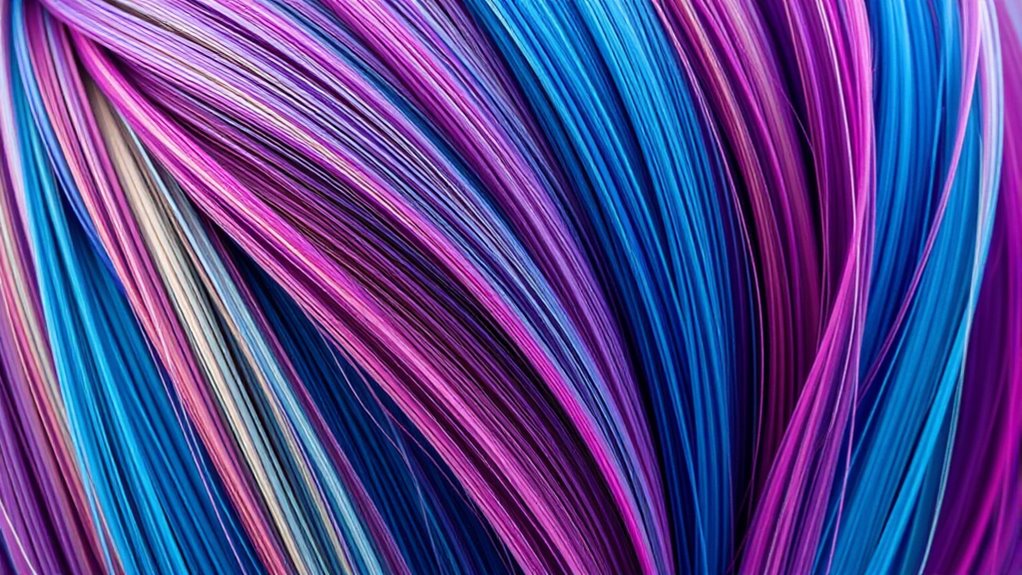
Opening the hair cuticle is a crucial step for ensuring that dye molecules can penetrate into the cortex, where the true color change occurs. Permanent dyes contain ammonia or similar alkaline agents to lift the cuticle, increasing permeability. This allows small dye precursors to enter the cortex, where they oxidize and form larger, insoluble pigments that become trapped for long-lasting color.
Semi-permanent dyes, lacking ammonia, only mildly swell or lift the cuticle, resulting in less penetration and surface-level coloring. Swelling and penetration enhancers can further improve dye uptake by temporarily increasing hair fiber diameter. These agents help dye molecules reach melanin sites in the cortex more effectively, leading to richer and more durable color in permanent dyes.
The degree of cuticle opening directly influences color intensity and longevity.
Durability and Maintenance of Permanent Vs Semi-Permanent Color

Permanent hair color generally lasts several weeks to months, making it a more durable option compared to semi-permanent dyes, which fade more quickly over time.
Semi-permanent color typically lasts around 4 to 12 washes or about 2 to 3 weeks, fading gradually without deep penetration. Because it doesn’t chemically alter the hair’s pigment, it requires more frequent reapplication but causes less damage.
Permanent dye, on the other hand, needs fewer touch-ups—usually every 4 to 8 weeks—and can be maintained with color-safe shampoos and conditioners. However, it may lead to dryness or damage, requiring regular moisturizing.
Semi-permanent color is more low-maintenance, ideal for temporary changes, while permanent color offers longer-lasting results with more involved upkeep.
Effects of Hair Structure on Dye Performance
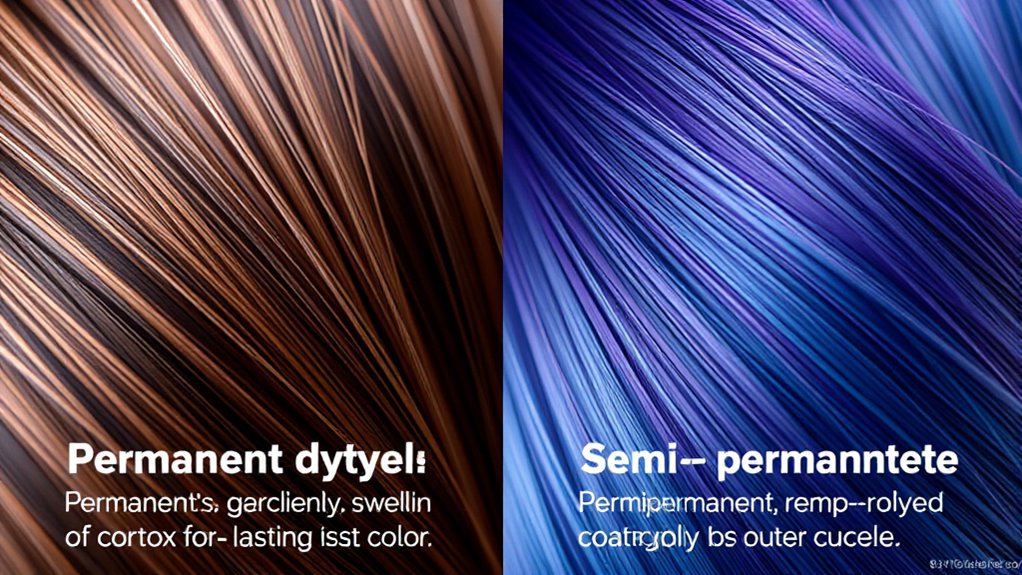
The effectiveness of hair dye depends heavily on the structure of your hair. Penetration depth is influenced by molecular size: permanent dyes use small precursor molecules that penetrate deep into the cortex, forming large, trapped molecules during oxidation.
Semi-permanent dyes rely on medium-sized molecules that enter but wash out more easily.
Damage from bleaching or perming increases porosity, allowing deeper dye penetration but risking structural harm.
Hair porosity varies: coarse hair resists absorption due to thicker cuticles, while fine hair absorbs dye quickly, risking damage.
Curly or coily hair has uneven porosity, leading to patchy color.
Raised cuticles from damage cause uneven dye uptake and faster fading.
Choosing the Right Hair Dye Based on Your Goals

Choosing the right hair dye depends on your personal goals and how much maintenance you’re willing to handle. If you want a natural look, selecting a shade close to your natural color minimizes damage and simplifies upkeep.
For gray coverage or dramatic changes, permanent dyes are ideal—they last longer but require regular root touch-ups every 4-6 weeks. Semi-permanent dyes fade gradually over 4-12 shampoos, making them perfect for experimenting or low-maintenance routines.
Your skin tone and undertone also matter; warm tones suit golden or copper shades, while cool undertones work better with ash or platinum hues. Consider your natural hair color and desired vibrancy, as lighter or darker changes impact processing time and hair health.
Ultimately, choose a dye that aligns with your style, maintenance preferences, and natural coloring.
Frequently Asked Questions
How Does Hair Porosity Affect Dye Absorption and Longevity?
You need to understand that hair porosity impacts how well your hair absorbs and retains dye. Low porosity hair resists dye penetration but holds color longer.
High porosity absorbs dye quickly but loses it faster. Medium porosity offers a balance, making it easier to achieve and maintain vibrant color.
Adjusting your dyeing process based on your hair’s porosity guarantees better absorption and longer-lasting results.
Can Hair Condition or Damage Influence Dye Results?
You might think healthy hair is just a bonus, but it actually transforms your dye results. Damaged or over-processed hair struggles to hold color, fading faster and often looking uneven.
Ironically, the more you damage your hair with harsh chemicals or heat, the poorer your color outcome becomes. So, if you want vibrant, lasting color, taking care of your hair’s condition isn’t just advice—it’s essential for perfect results.
Are There Safety Concerns With Ammonia-Based Dyes?
You should be aware that ammonia-based dyes can pose safety concerns. The ammonia irritates your skin, eyes, and respiratory system, especially with repeated exposure. It can cause dryness, brittleness, or chemical burns on your scalp.
Inhalation fumes might lead to respiratory issues, and some people could have allergic reactions. To stay safe, consider using ammonia-free options, guarantee good ventilation, and do patch tests before applying any hair dye.
How Do Different Hair Textures Impact Dye Application?
When it comes to dye application, your hair texture plays a big role. Fine hair absorbs color quickly and might need gentler products to prevent damage.
Coarse hair requires longer processing times or pre-lightening for even results.
Curly hair needs careful handling to avoid damage, while damaged hair may not hold color well.
Understanding your hair’s texture helps you choose the right products and techniques for vibrant, lasting color.
Is It Possible to Achieve Natural-Looking Color With Permanent Dye?
You might be surprised, but yes, you can achieve a natural-looking color with permanent dye. It’s all about choosing the right shade, applying it carefully, and possibly consulting a professional for the best results.
Customizing the formula and using techniques like gradual color buildup or balayage helps mimic natural tones. With proper care and skill, your new color can look effortlessly authentic and stunning.
Conclusion
Now that you know how hair dye works, you can navigate your color journey with confidence. Whether you want a lasting transformation or a temporary splash of hue, understanding the science helps you choose wisely. Think of permanent dyes as a bold melody, lasting and deep, while semi-permanent colors are like a playful dance—fun and fleeting. With this knowledge, your perfect shade is just a decision away, ready to sing on your hair’s stage.
